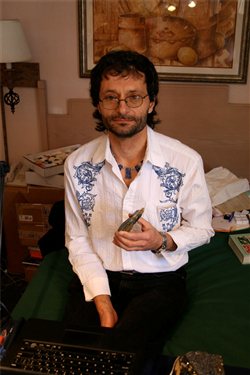 The first big day of activity at the 2010 Tucson Gem and Mineral Show saw me and my dad, John Eicher, an inveterate chemist, astronomy buff, mineralogist, and 88-year-old adventurer, set off for the best of the “satellite shows.” We got to the Hotel Tucson City Center (recently renamed from the InnSuites) looking for meteorites by 9 a.m., finding that most dealers weren’t awake and opening their doors until 10.
The first big day of activity at the 2010 Tucson Gem and Mineral Show saw me and my dad, John Eicher, an inveterate chemist, astronomy buff, mineralogist, and 88-year-old adventurer, set off for the best of the “satellite shows.” We got to the Hotel Tucson City Center (recently renamed from the InnSuites) looking for meteorites by 9 a.m., finding that most dealers weren’t awake and opening their doors until 10.
It was a cool day by Tucson standards, a bit breezy and pushing upwards of 60° F. It was funny for a Wisconsinite whose home was being pounded by (another) foot of snow to see westerners in the morning air here with winter coats on!
Soon the early risers among the dealers opened their doors, and we explored the stock of the Collector’s Edge, Crystal Classics, and others for nice mineral specimens. We talked and joked at length with Texas mineral dealer Jon Voelter, Bolivian mineral expert Alfredo Petrov (pictured at right), Czech author and great authority Jaroslav Hyrsl, and antique scientific instrument collector and dealer David Moore Spatz of Tucson — meteorite dealer Robert Haag’s brother-in-law. What a great group of experts, we thought, who were bubbling over with great stories and expertise.
Then our attention turned squarely toward meteorites. We visited several dealers, and I shot brief videos showcasing them and a selection of their specimens — more will follow over the coming days. French meteorite dealer Luc Labenne of Labenne Meteorites (www.meteorites.tv) showed us beautiful new lunar achondrites, Dhofar 1528 and 1527, one found by Luc and one by his brother, both in Oman. He also showed us Shisr 166, a lunar meteorite he had found in the desert in Oman at night! He showed us Minera Escondida, a bencubbenite from Chile.
Luc’s favorite meteorite of all comes from the Western Sahara, Itqiy, named for the village where it fell. A huge slice of this rare and primitive enstatite achondrite adorned the center of his display.
Down the hall was a spectacular room full of meteorites and the charming Anne Black of Impactika Meteorites, www.impactika.com. She showed us the largest collection of thin sections in the world, numbering 600 or so. She also offers a specialty of historic meteorite falls, such as Clark County, Kentucky, which was found in 1937. Anne also wants meteorite dealers to know about the great new edition of Alain Carion’s book Meteorites, available at the Impactika.com web site. This book is essential for novice collectors, a superb first guide.
Around the corner, we found another old friend, Mike Farmer, who operates his thriving meteorite business and calls his outstanding web site www.meteoritehunter.com. This rich web site has meteorites of all types for all collectors, as did his room. Mike showed us some fantastic pallasites including Esquel, Fukang, and many others, with beautiful olivine inclusions. He displayed nice iron meteorites, tektites including a basketball-sized piece of Libyan Desert Glass, and a big Murchison, the primitive carbonaceous chondrite that is chock full of amino acids. This was an exciting discovery in 1969 and points toward comets being a significant source of not only water but also organic.
We walked away from the show having seen a dazzling array of hundreds of meteorites and thousands of minerals, and will bring you highlights of many more tomorrow!
Visit our gallery of images from the 2010 Tucson Gem and Mineral Show, and be sure to follow Dave's updates from the Show on our Twitter (@AstronomyMag) and Facebook pages.
Photo by David J. Eicher